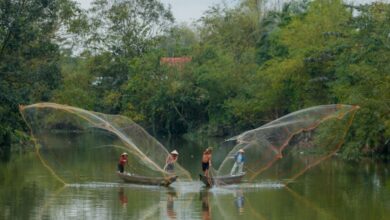Carrying Your Canoe during Portaging
Carrying a canoe during portaging is an essential skill for any paddler venturing into areas where the water isn’t always navigable. Whether you’re crossing a rocky path, a dense forest, or a muddy swamp, knowing how to efficiently and safely transport your canoe can make the difference between an enjoyable outing and a frustrating ordeal. This process requires technique, balance, and sometimes a little creativity.
Understanding Portaging Techniques
Portaging involves lifting your canoe out of the water and carrying it over land, usually between two bodies of water. The way you carry your canoe can significantly impact your comfort and efficiency. The most common method is the “canoe on the head” technique, where the canoe rests atop your head, allowing your hands to remain free for balance or carrying gear.
To begin, ensure the canoe is positioned correctly. Stand the canoe on its side, with the bow facing away from you. Squat down and grip the gunwales (the top edges of the canoe) with both hands. With a quick motion, lift the canoe onto your head, keeping your elbows close to your body to stabilize the load. Your neck and shoulders should bear most of the weight, so adjust the canoe’s position until it feels balanced.
Mastering the Balance
Once you have the canoe secured on your head, the next step is maintaining your balance. A slight shift in weight can throw you off, especially on uneven terrain. Keep your feet shoulder-width apart to create a stable base. When stepping over obstacles like roots or rocks, use your knees to absorb the impact and maintain your center of gravity.
To further enhance your stability, consider using a “portage yoke.” This device, often padded for comfort, attaches to the canoe’s gunwales and rests on your shoulders, redistributing the weight evenly. A yoke can significantly reduce fatigue, allowing for longer and more enjoyable portages.
Adjusting Your Grip
As you carry your canoe, be mindful of your grip. Your hands should be positioned firmly but not too tightly. A relaxed grip allows for better control and responsiveness, especially if you encounter sudden changes in terrain. If you’re traveling with a companion, communicate regularly to ensure both of you are moving in sync, which can help prevent accidents.
Planning Your Route
Before embarking on a portage, scout your route carefully. Look for the most efficient path that minimizes obstacles. Ideally, you want to avoid steep inclines and slippery surfaces. If possible, try to find a trail that other paddlers have used; this will often be the most manageable path. Always be aware of your surroundings, especially in unfamiliar territory, as unexpected hazards can arise.
Carrying Additional Gear
If you’re carrying gear in addition to your canoe, pack it strategically. Distribute weight evenly in your backpack or dry bags, and keep heavier items close to your back for better balance. Consider using a dolly or cart for heavier loads, which can alleviate some of the strain. Remember, the goal is to maintain a streamlined process that allows you to navigate efficiently while minimizing fatigue.
Safety Considerations
Safety should always be a priority during portaging. Wear appropriate footwear to protect your feet from sharp objects and ensure a solid grip. If you’re in a group, take turns carrying the canoe to prevent exhaustion. Always have a plan for emergencies, especially in remote areas. A first-aid kit and communication device can be lifesavers in unexpected situations.
Embracing the Experience
Portaging can be strenuous, but it also offers a chance to connect with nature and appreciate the beauty of your surroundings. As you carry your canoe, take a moment to breathe in the fresh air and observe the wildlife and plants around you. This mindful practice can transform what may seem like a chore into a rewarding part of your adventure.
Final Thoughts on Portaging
Carrying your canoe during portaging doesn’t have to be a daunting task. With the right techniques, preparation, and mindset, you can turn this phase of your outdoor journey into a seamless and enjoyable part of your experience. Embrace the challenge, refine your skills, and find joy in every step of your adventure. Happy paddling!







